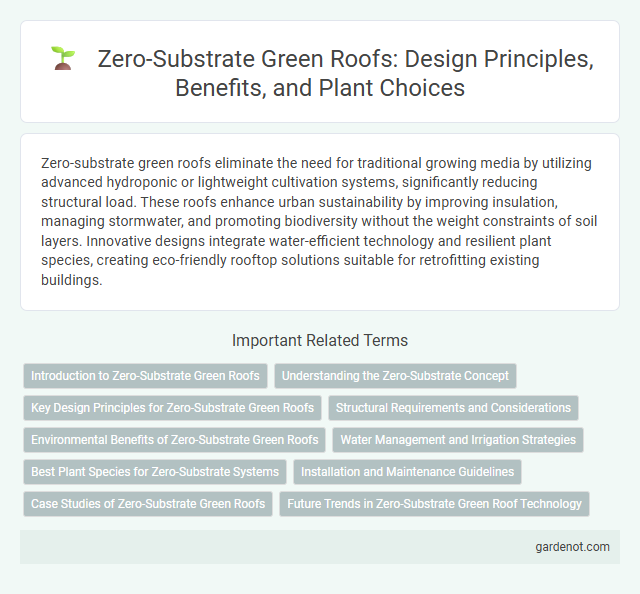Zero-substrate green roofs eliminate the need for traditional growing media by utilizing advanced hydroponic or lightweight cultivation systems, significantly reducing structural load. These roofs enhance urban sustainability by improving insulation, managing stormwater, and promoting biodiversity without the weight constraints of soil layers. Innovative designs integrate water-efficient technology and resilient plant species, creating eco-friendly rooftop solutions suitable for retrofitting existing buildings.
Introduction to Zero-Substrate Green Roofs
Zero-substrate green roofs utilize lightweight, soil-free systems that support vegetation through hydroponic or mat-based layers, significantly reducing structural load on buildings. These roofs improve urban sustainability by enhancing stormwater management, insulating buildings, and promoting biodiversity without the need for traditional soil substrates. Advanced materials like nutrient-rich mats and water retention layers enable efficient plant growth while minimizing maintenance requirements in zero-substrate green roof designs.
Understanding the Zero-Substrate Concept
Zero-substrate green roofs eliminate traditional soil layers by utilizing alternative growing media or structural supports to sustain vegetation, reducing overall roof weight and improving water retention efficiency. This system relies on lightweight, nutrient-rich mats or engineered materials designed to promote plant growth while minimizing substrate needs. Understanding the zero-substrate concept is essential for optimizing green roof performance, sustainability, and long-term maintenance in urban environments.
Key Design Principles for Zero-Substrate Green Roofs
Zero-substrate green roofs rely on lightweight, modular systems that eliminate traditional soil layers to reduce structural load and increase installation flexibility. Key design principles include selecting drought-tolerant, low-maintenance vegetation like succulents or native grasses capable of thriving in minimal growing media. Efficient water drainage, root barrier integration, and careful plant species calibration are critical to ensure sustainability and optimal thermal insulation.
Structural Requirements and Considerations
Zero-substrate green roofs demand specialized structural requirements focused on lightweight support systems due to the absence of traditional growing media. The roof must incorporate advanced waterproofing and drainage layers to prevent moisture retention and structural damage. Considerations include load-bearing capacity, thermal insulation enhancement, and integration with existing roofing materials to ensure durability and energy efficiency.
Environmental Benefits of Zero-Substrate Green Roofs
Zero-substrate green roofs significantly enhance urban biodiversity by providing habitats without adding heavy growing media, reducing structural load on buildings. They improve stormwater management by facilitating natural water infiltration and minimizing runoff, which decreases the risk of urban flooding. This type of green roof also contributes to carbon sequestration and lowers urban heat island effects, promoting overall environmental sustainability.
Water Management and Irrigation Strategies
Zero-substrate green roofs utilize a minimalist growing medium or none at all, optimizing water retention by relying primarily on specialized waterproof layers and engineered drainage systems to control runoff and prevent waterlogging. Innovative irrigation strategies include precision drip irrigation and smart moisture sensors that activate only when necessary, significantly reducing water consumption while ensuring plant health. These roofs enhance urban stormwater management by capturing and slowly releasing rainwater, mitigating flood risks and reducing the burden on municipal drainage infrastructure.
Best Plant Species for Zero-Substrate Systems
Succulent species such as Sedum and Sempervivum excel on zero-substrate green roofs due to their drought tolerance and minimal nutrient requirements. Native grasses like Bouteloua gracilis thrive in shallow systems by efficiently using limited water resources. These plants enhance green roof longevity by adapting to extreme environmental conditions without a traditional growing medium.
Installation and Maintenance Guidelines
Zero-substrate green roofs require specialized installation techniques involving the direct integration of vegetation mats or pre-grown plant layers onto waterproof membranes, eliminating the need for traditional soil substrates. Maintenance guidelines emphasize routine inspection of irrigation systems, careful control of plant species to prevent invasive growth, and regular removal of debris to ensure optimal plant health and water retention efficiency. Employing durable root barriers and selecting drought-resistant plants are key practices to enhance longevity and reduce maintenance demands on zero-substrate green roofs.
Case Studies of Zero-Substrate Green Roofs
Case studies of zero-substrate green roofs demonstrate significant improvements in stormwater management and urban heat island mitigation, particularly in dense metropolitan areas like Tokyo and Singapore. These installations utilize innovative hydroponic systems eliminating traditional soil substrates, reducing structural load while promoting efficient plant growth and biodiversity. Research from organizations such as the Urban Green Council highlights increased energy savings and extended roof lifespan compared to conventional green roofing methods.
Future Trends in Zero-Substrate Green Roof Technology
Zero-substrate green roof technology is advancing with innovations in lightweight, hydroponic systems that eliminate traditional growing mediums to reduce structural load on buildings. Future trends emphasize integrating smart irrigation controls and remote monitoring to optimize water use and plant health in urban environments. Research is also focusing on enhancing plant species diversity and resilience to improve ecological benefits and adaptability under changing climate conditions.
Zero-substrate green roof Infographic

 gardenot.com
gardenot.com